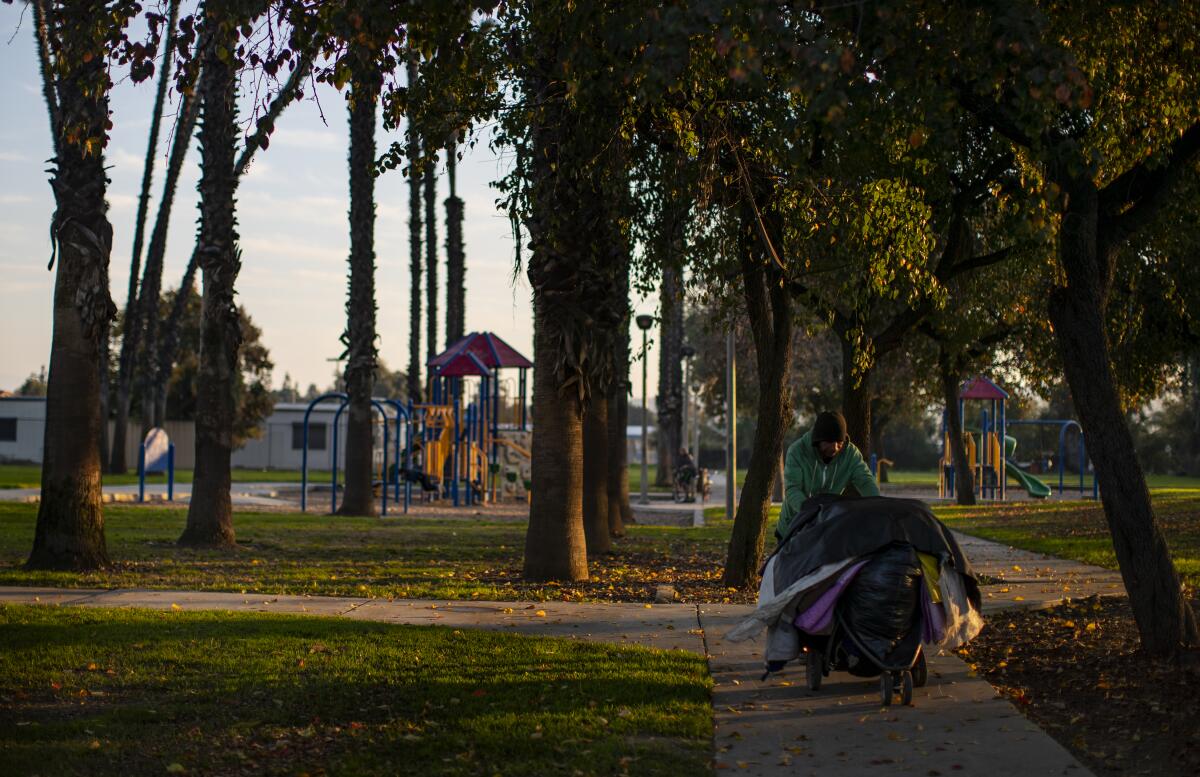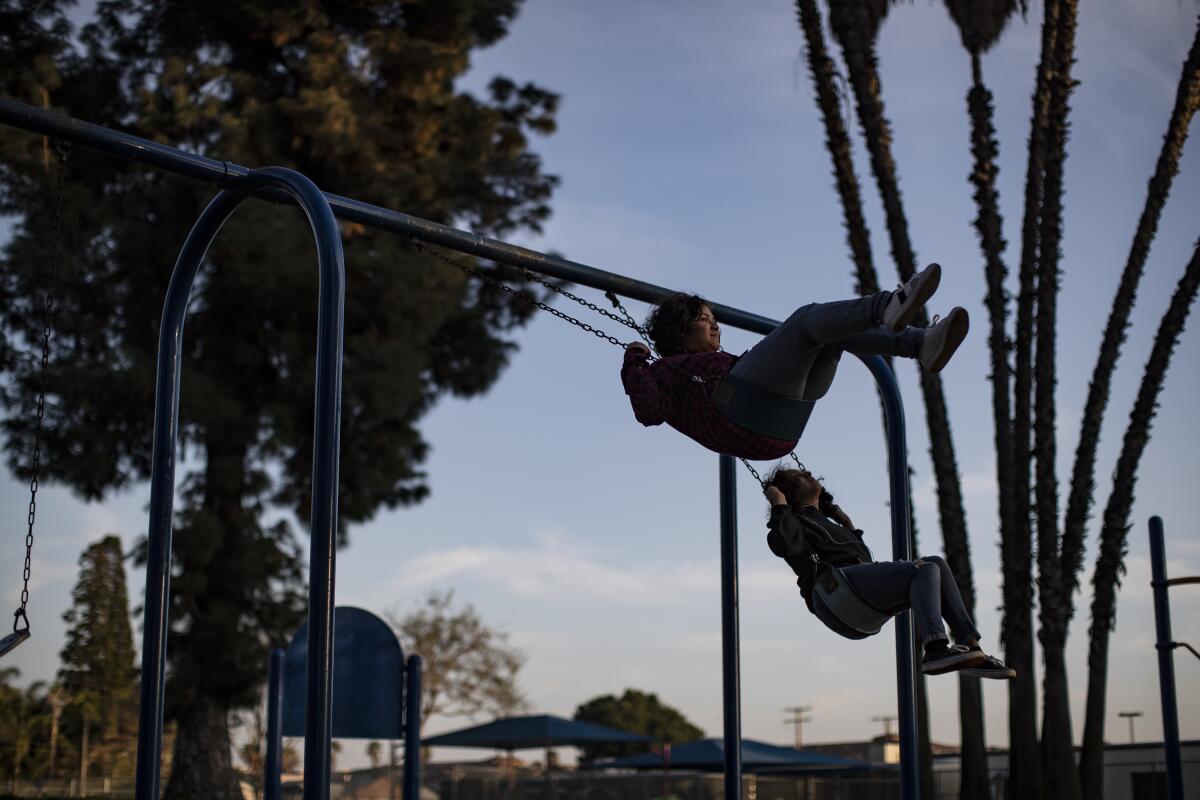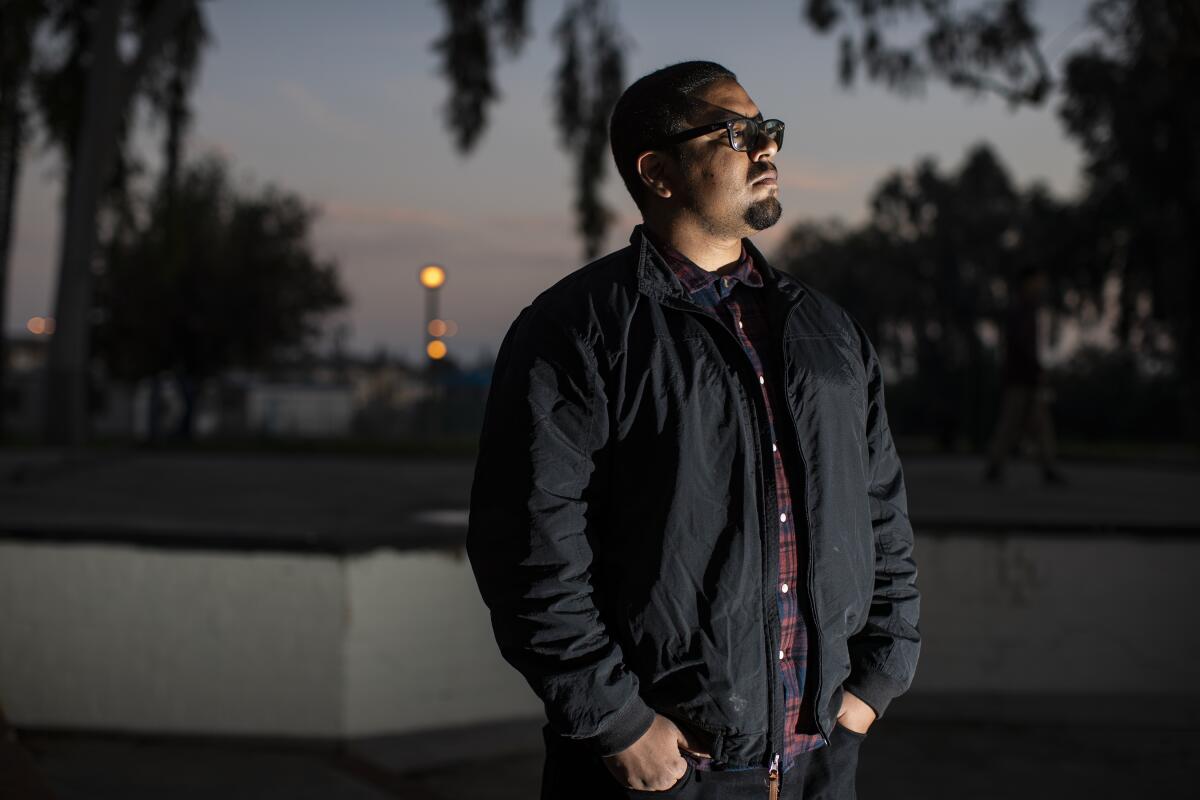A mural at a troubled park was meant to honor Native Americans. Instead, it caused anger

Last summer, Joe Ded painted a mural on a dilapidated bandstand at Tony Cerda Park in Pomona as a symbol of hope.
Its theme: a hodgepodge of Native American symbols to honor the parkâs namesake, a boxing coach who grew up nearby and was the longtime chair of the Costanoan Band of Carmel Mission Indians, also known as the Ohlone. The children and parents who helped Ded hailed the mural as a first step toward bringing back dignity to the green space, long neglected by the city and long infamous as a place that canât seem to ever get a break.
The four-acre expanse of cracked walkways, patches of dead grass, tagged-up trees and gross restrooms was originally called Sharkey Park after Pomonaâs oldest Latino gang. In 1970, police raided a softball game and arrested 53 people, inciting a riot; in the years that followed, so many shootings and killings and brawls plagued Sharkey that residents accused officers of being too scared to patrol it. A City Council member even suggested the park get bulldozed and sold off to developers.
But the bandstand mural was having its intended effect. Spoken-word nights were organized there. Baby agave planted by residents next to it began to grow. Graffiti stayed away. Families sat where cholos once glared.
Then the park got snakebit by controversy once more.
Native American activists soon complained that the icons depicted on the mural â Mayan glyphs, an Aztec eagle, a Zia sun symbol, the Southwestern fertility god Kokopelli â werenât indigenous to the region and thus offensive. They wanted the mural gone.
Opponents interrupted readings at the mural to complain. Pomonaâs parks and recreation committee meetings â usually placid affairs â became the stage for heated accusations about how the mural committed âcultural genocide.â
âWe have justification for feeling the way we do,â Dee Dee Manzanares, chair of an Ohlone faction, told the Pomona City Council during its Jan. 6 meeting. âI have never been so humiliated like I was here in my own hometown. I felt so small.â
Native Americans, tired of the endless appropriation and mislabeling of their culture, were asking the cityâs elected officials to take a stand on their behalf.
The decision, though, wasnât so easy.
âIt created confusion, anger, frustration,â said Pomona Mayor Tim Sandoval during the Jan. 6 meeting. âWe as a community have so many challenges, the last thing we need to do is fight with each other over a mural.â

Paul Apodaca, a Chapman University sociology professor who was a founding contributor to the Smithsonian Institution National Museum of the American Indian, said critics of the mural had every right to feel upset.
âThe specificity of each American culture, like the specificity of each European culture, is important,â he said. âThe move away from stereotype and cultural appropriation requires some research and effort to present culture groups and their representation with respect, care and input from the cultures represented. â
Councilman Victor Preciado, who grew up in Pomona and whose district includes Tony Cerda Park, said the park âwasnât a priorityâ for previous administrations because of its location: south Pomona, the cityâs traditional Latino barrio. Now, the 31-year-old said, âweâre creating surveys and talking to people to see what they want there.â
And one of those things was a mural.
But the council, much to Dedâs anger, voted unanimously to destroy the artwork â with Preciado recusing himself. It was painted over within 24 hours.
âDang, what was this, the Berlin Wall?â he said. âPeople have too much time on their hands. Just accept something that makes a park pretty.â
But the muralâs demise has unwittingly accomplished its goal. Residents angered by the the situation vow to continue to nurture the park.
Sofie Reyes, 53, has lived across the street from Tony Cerda for 30 years, but always took her children and grandchildren to Salazar Park in East Los Angeles for weekend fun. Now sheâs part of a group that regularly cleans up the park and wants more events such as poetry readings and concerts.
âI didnât even know there was a [bandstand] here until the mural,â she said. âThatâs how little people use the park. Thereâs nothing there. Nothing.â
On a recent weekday morning, Tony Cerda Park was empty save for 28-year-old Jhonny Galvan, who watched his son run around in the playpen. Nearby, remnants of the mural â a childâs hand print, the outline of a feather â peeked through the glops of white paint that covered it, a ghostly reminder of what once was. Meanwhile, someone had scribbled âPomona 12â on the edge, the modern moniker of the Sharkeys.
Galvan thought the mural âwas coolâ and didnât understand why anyone would find it problematic. âAnything to bring more positiveness back here is good,â he said.
Whatâs now Tony Cerda Park started out as a vacant lot. Residents carved out a baseball field in the late 1960s, and asked the City Council for funds to build picnic benches, a football field, drinking fountains, trash cans and a youth center, among other amenities.
They got the trash cans.
Council members said there wasnât enough money to make the park nicer, and even delayed the construction of restrooms for years. About the only nod to neighborhood demands was a name change in 1973 from Madison Park to Sharkey, in an effort to get the gang and other area youths to take care of their stomping grounds.
No one voiced any dissent at the time; instead, parks and recreation commissioners asked for a jacket with the gangâs name on it so that city staff could get the spelling right.
Soon, Sharkey became notorious as one of the roughest areas in a city that became nationally known for gang violence. âIf we ventured over there, we could run into trouble, and it could cost us our lives,â said Carlos Goytia, a lifelong Pomona resident. âIt was a horrendous experience to grow up in.â
The scene became so bad that then-Councilman Clay Bryant argued for the parkâs eradication in 1988 â âitâs getting to be the more parks you have, the more hangouts you have for the gangs,â he said. His effort went nowhere, but in 1989 the city changed the name back to Madison to shake off the parkâs stigma. (It was renamed Tony Cerda in 2008).
The Cinco de Mayo and Mexican Independence Day celebrations and Easter egg hunts that once regularly happened here disappeared, leaving the park largely empty except for weekend soccer leagues and an annual powwow run by the Costanoans. What remained at the park became so decrepit that a light pole fell just feet away from players during a match in September.

By the time Pomona parks and recreation Commissioner Fabian Pavon visited last spring, he hadnât stepped foot in it since preschool, even though he grew up just a block away.
âI was part of a generation of kids that was told, âYou go, youâre gonna get shot up, youâre gonna get gangbanged,ââ the 25-year-old said.
Pavon admitted to âa sense of fearâ when he returned to Tony Cerda Park. But those feelings turned into disgust. On Instagram, he posted photos of unsightly concrete slabs where picnic tables once stood, and ratty curtains installed by residents in the menâs restroom between a urinal and a toilet because there was no stall. The womanâs restroom, meanwhile, featured a paint bucket as a trash can.
âThe conditions were a disgrace,â he said.
With the help of Goytia and others, Pavon organized a cleanup and asked Ded to do the mural. Its removal, Pavon said, was âa disrespectâ to a community thatâs âbeen thrown under the bus and taken advantage of for generations.â
Mayor Sandoval says the decision to remove Dedâs tableau was purely procedural: Ded never pulled a permit. (The cityâs cultural arts commission retroactively granted one in November.) He wants to bring more programming to Tony Cerda Park beyond the occasional film nights the city has offered for some years.
And Sandoval points out that the city is slowly improving its infrastructure as part of $720,000 set aside for park facilities in Pomonaâs budget. In November, the city replaced all the light poles and installed four picnic benches. Thereâs even plans for an official mural on the restrooms.
âWhen people go to parks, they want to have a good park,â Sandoval said.
Goytia remains unconvinced about the cityâs efforts.
âWe just wanted to bring life to a park,â said the 50-year-old, who represents Pomona as a board member of the Three Valleys Metropolitan Water District. âInstead, we got whitewashed.â
But heâs at least happy that the hubbub has reinvigorated residents.
âNow,â Goytia said, âthe park is getting the attention that itâs deserved for decades on decades.â
More to Read
Sign up for Essential California
The most important California stories and recommendations in your inbox every morning.
You may occasionally receive promotional content from the Los Angeles Times.











